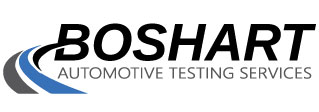IPT – In-Use Performance Tracking
 If you have been contacted by Boshart Automotive Testing Services to take part in a vehicle data collection program, this page will explain why we are interested in your real world driving experience and vehicle use.
If you have been contacted by Boshart Automotive Testing Services to take part in a vehicle data collection program, this page will explain why we are interested in your real world driving experience and vehicle use.
Boshart has contracts with numerous major vehicle manufacturers to contact vehicle owners to acquire emission related data from the their cars’ OBD-II systems. OBD stands for On Board Diagnostics, and data is retrieved from the car’s ECM (engine control module), which is a part of the OBD System. The ECM could be called the engine’s computer. This process is required by the California Air Resources Board’s (CARB) regulation 1968.2(j)(3) from every vehicle manufacturer selling vehicles in California. More information can be found at www.arb.ca.gov. If you would like to read the specific regulation, press control and click on this link:http://www.arb.ca.gov/regact/obd02/fro1968-2.pdf.
Should you receive a letter from Boshart and a major vehicle manufacturer, then your vehicle has been chosen as a potential candidate for this program. There is no obligation or charge to you.
Owner’s vehicles must meet acceptance criteria in order to participate including:
- The vehicle must have at least 500-1000 miles (depends on manufacturer)
- The vehicle’s ECM must not have been replaced or reflashed
- The vehicle’s Check Engine Light has not illuminated or flashed during normal driving
- The vehicle’s battery has not been disconnected within 2 months of data retrieval
To thank selected owners for their participation in these programs, we offer an incentive check or gift card as prescribed by the manufacturer. The check or gift card will be awarded to the participant as soon as the data retrieval procedure is completed.
Data collection takes approximately 20 minutes and can be scheduled at your home, business or other location of your choice. Your vehicle will not be driven, and the data retrieval will not alter or harm your vehicle in any way.
Q: What is the purpose of the data collection? What data is being collected and who will see the data?
A: In order to comply with California Code Regulation (CCR), Title 13 section 1968.2 (j)(3), auto manufacturers must collect and submit in-use monitor performance tracking data from a minimum of 15 vehicles within 12 months after the start of normal production or start of commerce, whichever is later. In-use monitor performance tracking data is used to verify whether the non-continuous On-Board Diagnostic (OBD) monitors are running with sufficient frequency under real-world or in-use conditions. In some cases, other OBD-II related data is collected to supplement the in-use monitor performance tracking data. Data collected is then submitted to the California Air Resources Board (CARB), thus completing the manufacturer’s obligations to the regulation.
Q: How is the data collected? Will it have any effect on my vehicle?
A: The data is collected by connecting a scan tool, pass-thru device or engineering tool to the SAE J1962, OBD-II Data Link Connector (DLC) located inside your vehicle. The data collection will have absolutely no affect to the vehicle.
Q: What if one of the monitors is not meeting the minimum frequency requirement? Will I receive feedback on the data collection?
A: Different driving styles, habits and conditions affect the OBD monitors in an untold number of ways. Even the most robust monitor may not run with ample frequency under every such condition. Fortunately for everyone, the government understands this fact and is simply using this system as an early warning device to manufacturers and to the California Air Resources Board that certain monitors may not be running with sufficient frequency, and may need to be redesigned or modified to meet the requirements. If you would like feedback on the data collected from your particular vehicle, please contact our OBD-II specialist at info@boshartatsc.om
Q: What exactly is OBD-II and what is a “monitor?”
A: On-Board Diagnostics Second Generation (OBD-II) essentially equates to the standardization of emission related on-board diagnostics. Prior to 1996, each manufacturer used their own unique form of an on-board diagnostics system, each with their own set of fault codes, data link connectors and MIL illumination protocols, just to name a few. With the advent of OBD-II, many of these variables became standardized. Although monitoring strategies remain unique, the goals that each manufacturer must achieve when designing their OBD systems are the same. In order to comply with OBD-II standards, manufacturers must “monitor” certain components and systems for failures, therefore inferring that emissions have exceeded applicable thresholds. Thus, OBD-II can also be thought of as on on-board emission analyzer. The operator of the vehicle is alerted to a failure through the illumination of the emission Malfunction Indicator Light (MIL). The illumination of the MIL corresponds to one or more Diagnostic Trouble Codes (DTC) being set by one or more monitors. A scan tool through the DLC can access these DTC’s and help pinpoint the failure. If the monitors do not run or run infrequently, exceedance of emission thresholds are less likely to be detected. Hence the concern over the frequency at which the monitors run.
Q: Where can I find more information regarding this requirement?
A: More information can be found at www.arb.ca.gov. If you would like to read the specific regulation, press control and click on this link: http://www.arb.ca.gov/regact/obd02/fro1968-2.pdf. You may also contact Boshart at info@bosharts.com for more information.
